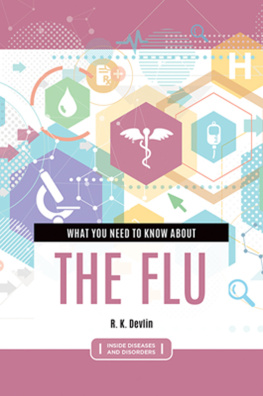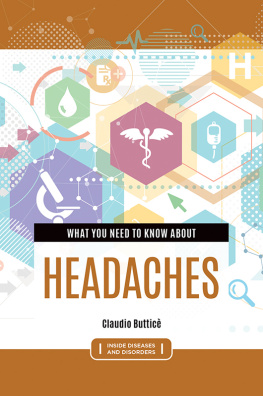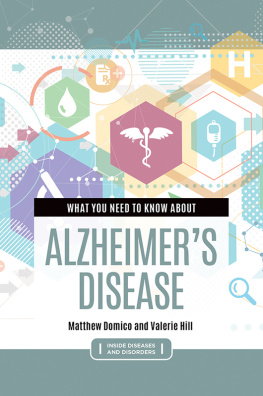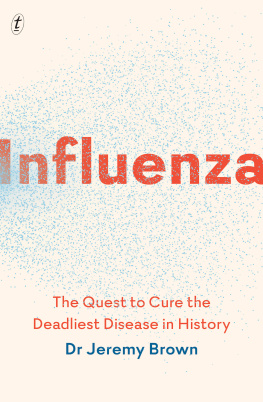Recent Titles in
Inside Diseases and Disorders
What You Need to Know about Autism
Christopher M. Cumo
What You Need to Know about ADHD
Victor B. Stolberg
What You Need to Know about ALS
Harry LeVine III
What You Need to Know about Eating Disorders
Jessica Bartley and Melissa Streno
What You Need to Know about Diabetes
Tish Davidson
What You Need to
Know about the Flu
R. K. Devlin
Inside Diseases and Disorders

What You Need to
Know about the Flu
Copyright 2021 by ABC-CLIO, LLC
All rights reserved. No part of this publication may be reproduced, stored in a retrieval system, or transmitted, in any form or by any means, electronic, mechanical, photocopying, recording, or otherwise, except for the inclusion of brief quotations in a review, without prior permission in writing from the publisher.
Library of Congress Cataloging-in-Publication Data
Names: Devlin, Roni K., 1968- author.
Title: What you need to know about the flu / R. K. Devlin.
Description: Santa Barbara, California : Greenwood, [2021] | Series: Inside diseases and disorders | Includes bibliographical references and index.
Identifiers: LCCN 2020018708 (print) | LCCN 2020018709 (ebook) | ISBN 9781440870071 (hardcover) | ISBN 9781440870088 (ebook)
Subjects: LCSH: Influenza.
Classification: LCC RC150 .D47 2021 (print) | LCC RC150 (ebook) | DDC 616.2/03dc23
LC record available at https://lccn.loc.gov/2020018708
LC ebook record available at https://lccn.loc.gov/2020018709
ISBN: 978-1-4408-7007-1 (print)
978-1-4408-7008-8 (ebook)
25 24 23 22 21 1 2 3 4 5
This book is also available as an eBook.
Greenwood
An Imprint of ABC-CLIO, LLC
ABC-CLIO, LLC
147 Castilian Drive
Santa Barbara, California 93117
www.abc-clio.com
This book is printed on acid-free paper 
Manufactured in the United States of America
This book discusses treatments (including types of medication and other therapies), diagnostic tests for various symptoms and other disorders, and organizations. The author has made every effort to present accurate and up-to-date information. However, the information in this book is not intended to recommend or endorse particular treatments or organizations, or substitute for the care or medical advice of a qualified health professional, or to be used to alter any medical therapy without a medical doctors advice. Specific situations may require specific therapeutic approaches not included in this book. For those reasons, we recommend that readers follow the advice of qualified health care professionals directly involved in their care. Readers who suspect they may have specific medical problems should consult a physician about any suggestions made in this book.
Contents
Disease is as old as humanity itself, and it has been the leading cause of death and disability throughout history. From the Black Death in the Middle Ages to smallpox outbreaks among Native Americans to the modern-day epidemics of diabetes and heart disease, humans have lived withand died fromall manner of ailments, whether caused by infectious agents, environmental and lifestyle factors, or genetic abnormalities. The field of medicine has been driven forward by our desire to combat and prevent disease and to improve the lives of those living with debilitating disorders. And while we have made great strides forward, particularly in the last 100 years, it is doubtful that mankind will ever be completely free of the burden of disease.
Greenwoods Inside Diseases and Disorders series examines some of the key diseases and disorders, both physical and psychological, affecting the world today. Some (such as diabetes, cardiovascular disease, and ADHD) have been selected because of their prominence within modern America. Others (such as Ebola, celiac disease, and autism) have been chosen because they are often discussed in the media and, in some cases, are controversial or the subject of scientific or cultural debate.
Because this series covers so many different diseases and disorders, we have striven to create uniformity across all books. To maximize clarity and consistency, each book in the series follows the same format. Each begins with a collection of frequently asked questions about the disease or disorder, followed by clear, concise answers. profiles cutting-edge research and speculates on how things might change in the next few decades.
Each volume also features five fictional case studies to illustrate different aspects of the books subject matter, highlighting key concepts and themes that have been explored throughout the text. The reader will also find a glossary of terms and a collection of print and electronic resources for additional information and further study.
As a final caveat, please be aware that the information presented in these books is no substitute for consultation with a licensed health care professional. These books do not claim to provide medical advice or guidance.
Hippocrates (460375 BCE) was a Greek physician and teacher who is now known as the Father of Medicine. In 412 BCE, in the Book of Epidemics, Hippocrates was thought to be one of the first to describe an illness suggestive of influenza. He noted a flu-like syndrome called fever of Perinthus or cough of Perinthus, which described a winter and a spring epidemic of an upper respiratory tract infection that occurred regularly every year at a port town called Perinthus, located in the northern part of Greece that is now Turkey. Other similar descriptions of a sickness thought to be influenza have been found written on paper dating back to the Middle Ages. In the fifteenth century, the term influenza originated in Italy for the first time to describe this episodic, but recurrent, clinical syndrome attributed to the influence of the stars; the word was adopted into English in the eighteenth century. Today, people across the globe often refer to it simply as the flu. The disease, by whatever name, and the germ that causes it, is the topic of this book.
Despite all we now know about the influenza virus and the infectious disease it causes, it remains a source of tremendous grief for humankind. Every year, influenza circulates through small towns and cities alike all across the globe as a seasonal infection. Its estimated that influenza infects between 5 and 15 percent of the worlds population each year, with even higher numbers in children (about 30 percent). These statistics suggest that every person will be infected or exposed to the flu virus by the time they are four years old. A more recent study looking at seasonal flu between 2010 and 2018 in the United States has shown that the virus resulted in up to 23 million medical visits, almost a million hospitalizations, and up to 79,000 respiratory and circulatory deaths each year. Worldwide, it has been estimated that up to 645,000 respiratory deaths are associated with influenza annually.
While these statistics of severe disease and death are shockingly impressive, there are other consequences of influenza that are often overlooked: lost productivity from missed days at work, sky-high costs of medical care, and other economic burdens. One study that looked at the consequences of influenza in the United States based on the 2003 population found that direct medical costs averaged $10.4 billion annually, projected lost earnings due to illness and death amounted to $16.3 billion each year, and the total economic burden of annual influenza epidemics reached $87.1 billion.













